Hongyu Gong
AV-Flow: Transforming Text to Audio-Visual Human-like Interactions
Feb 18, 2025Abstract:We introduce AV-Flow, an audio-visual generative model that animates photo-realistic 4D talking avatars given only text input. In contrast to prior work that assumes an existing speech signal, we synthesize speech and vision jointly. We demonstrate human-like speech synthesis, synchronized lip motion, lively facial expressions and head pose; all generated from just text characters. The core premise of our approach lies in the architecture of our two parallel diffusion transformers. Intermediate highway connections ensure communication between the audio and visual modalities, and thus, synchronized speech intonation and facial dynamics (e.g., eyebrow motion). Our model is trained with flow matching, leading to expressive results and fast inference. In case of dyadic conversations, AV-Flow produces an always-on avatar, that actively listens and reacts to the audio-visual input of a user. Through extensive experiments, we show that our method outperforms prior work, synthesizing natural-looking 4D talking avatars. Project page: https://aggelinacha.github.io/AV-Flow/
DC-Spin: A Speaker-invariant Speech Tokenizer for Spoken Language Models
Oct 31, 2024Abstract:Spoken language models (SLMs) have gained increasing attention with advancements in text-based, decoder-only language models. SLMs process text and speech, enabling simultaneous speech understanding and generation. This paper presents Double-Codebook Speaker-invariant Clustering (DC-Spin), which aims to improve speech tokenization by bridging audio signals and SLM tokens. DC-Spin extracts speaker-invariant tokens rich in phonetic information and resilient to input variations, enhancing zero-shot SLM tasks and speech resynthesis. We propose a chunk-wise approach to enable streamable DC-Spin without retraining and degradation. Comparisons of tokenization methods (self-supervised and neural audio codecs), model scalability, and downstream task proxies show that tokens easily modeled by an n-gram LM or aligned with phonemes offer strong performance, providing insights for designing speech tokenizers for SLMs.
Investigating Decoder-only Large Language Models for Speech-to-text Translation
Jul 03, 2024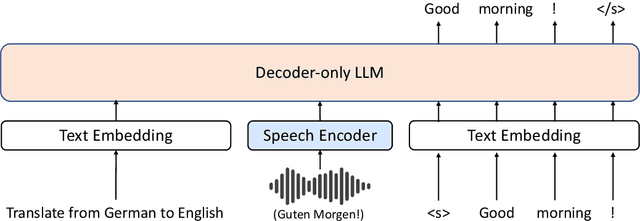

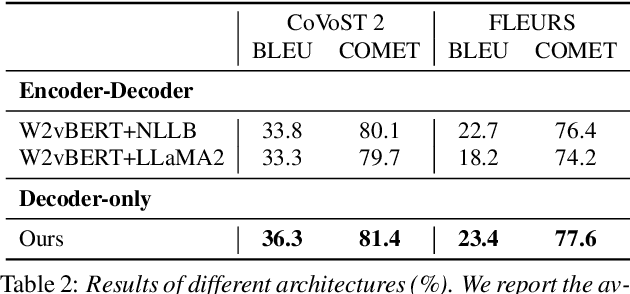
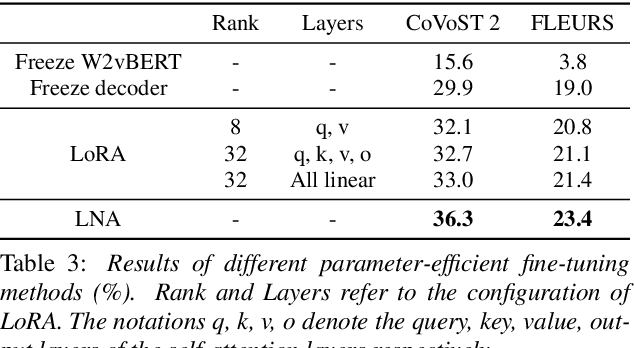
Abstract:Large language models (LLMs), known for their exceptional reasoning capabilities, generalizability, and fluency across diverse domains, present a promising avenue for enhancing speech-related tasks. In this paper, we focus on integrating decoder-only LLMs to the task of speech-to-text translation (S2TT). We propose a decoder-only architecture that enables the LLM to directly consume the encoded speech representation and generate the text translation. Additionally, we investigate the effects of different parameter-efficient fine-tuning techniques and task formulation. Our model achieves state-of-the-art performance on CoVoST 2 and FLEURS among models trained without proprietary data. We also conduct analyses to validate the design choices of our proposed model and bring insights to the integration of LLMs to S2TT.
Textless Acoustic Model with Self-Supervised Distillation for Noise-Robust Expressive Speech-to-Speech Translation
Jun 04, 2024Abstract:In this paper, we propose a textless acoustic model with a self-supervised distillation strategy for noise-robust expressive speech-to-speech translation (S2ST). Recently proposed expressive S2ST systems have achieved impressive expressivity preservation performances by cascading unit-to-speech (U2S) generator to the speech-to-unit translation model. However, these systems are vulnerable to the presence of noise in input speech, which is an assumption in real-world translation scenarios. To address this limitation, we propose a U2S generator that incorporates a distillation with no label (DINO) self-supervised training strategy into it's pretraining process. Because the proposed method captures noise-agnostic expressivity representation, it can generate qualified speech even in noisy environment. Objective and subjective evaluation results verified that the proposed method significantly improved the performance of the expressive S2ST system in noisy environments while maintaining competitive performance in clean environments.
SeamlessExpressiveLM: Speech Language Model for Expressive Speech-to-Speech Translation with Chain-of-Thought
May 30, 2024Abstract:Expressive speech-to-speech translation (S2ST) is a key research topic in seamless communication, which focuses on the preservation of semantics and speaker vocal style in translated speech. Early works synthesized speaker style aligned speech in order to directly learn the mapping from speech to target speech spectrogram. Without reliance on style aligned data, recent studies leverage the advances of language modeling (LM) and build cascaded LMs on semantic and acoustic tokens. This work proposes SeamlessExpressiveLM, a single speech language model for expressive S2ST. We decompose the complex source-to-target speech mapping into intermediate generation steps with chain-of-thought prompting. The model is first guided to translate target semantic content and then transfer the speaker style to multi-stream acoustic units. Evaluated on Spanish-to-English and Hungarian-to-English translations, SeamlessExpressiveLM outperforms cascaded LMs in both semantic quality and style transfer, meanwhile achieving better parameter efficiency.
An Empirical Study of Speech Language Models for Prompt-Conditioned Speech Synthesis
Mar 19, 2024



Abstract:Speech language models (LMs) are promising for high-quality speech synthesis through in-context learning. A typical speech LM takes discrete semantic units as content and a short utterance as prompt, and synthesizes speech which preserves the content's semantics but mimics the prompt's style. However, there is no systematic understanding on how the synthesized audio is controlled by the prompt and content. In this work, we conduct an empirical study of the widely used autoregressive (AR) and non-autoregressive (NAR) speech LMs and provide insights into the prompt design and content semantic units. Our analysis reveals that heterogeneous and nonstationary prompts hurt the audio quality in contrast to the previous finding that longer prompts always lead to better synthesis. Moreover, we find that the speaker style of the synthesized audio is also affected by the content in addition to the prompt. We further show that semantic units carry rich acoustic information such as pitch, tempo, volume and speech emphasis, which might be leaked from the content to the synthesized audio.
MSLM-S2ST: A Multitask Speech Language Model for Textless Speech-to-Speech Translation with Speaker Style Preservation
Mar 19, 2024Abstract:There have been emerging research interest and advances in speech-to-speech translation (S2ST), translating utterances from one language to another. This work proposes Multitask Speech Language Model (MSLM), which is a decoder-only speech language model trained in a multitask setting. Without reliance on text training data, our model is able to support multilingual S2ST with speaker style preserved.
Seamless: Multilingual Expressive and Streaming Speech Translation
Dec 08, 2023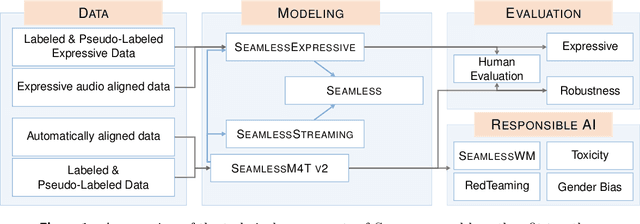
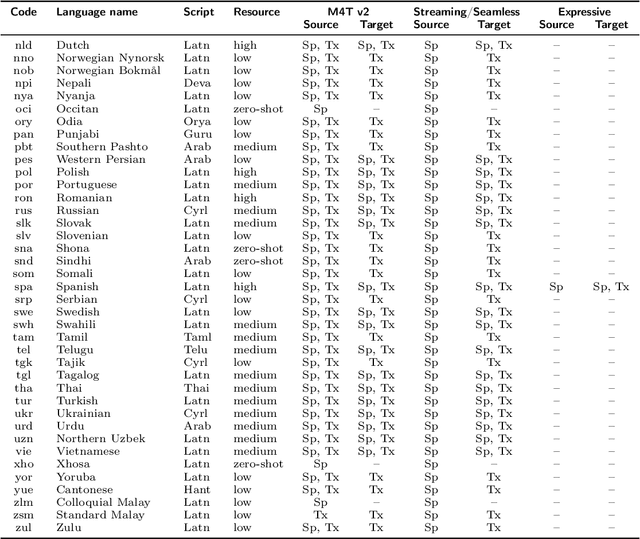

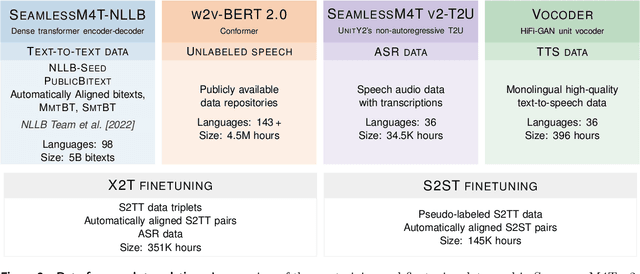
Abstract:Large-scale automatic speech translation systems today lack key features that help machine-mediated communication feel seamless when compared to human-to-human dialogue. In this work, we introduce a family of models that enable end-to-end expressive and multilingual translations in a streaming fashion. First, we contribute an improved version of the massively multilingual and multimodal SeamlessM4T model-SeamlessM4T v2. This newer model, incorporating an updated UnitY2 framework, was trained on more low-resource language data. SeamlessM4T v2 provides the foundation on which our next two models are initiated. SeamlessExpressive enables translation that preserves vocal styles and prosody. Compared to previous efforts in expressive speech research, our work addresses certain underexplored aspects of prosody, such as speech rate and pauses, while also preserving the style of one's voice. As for SeamlessStreaming, our model leverages the Efficient Monotonic Multihead Attention mechanism to generate low-latency target translations without waiting for complete source utterances. As the first of its kind, SeamlessStreaming enables simultaneous speech-to-speech/text translation for multiple source and target languages. To ensure that our models can be used safely and responsibly, we implemented the first known red-teaming effort for multimodal machine translation, a system for the detection and mitigation of added toxicity, a systematic evaluation of gender bias, and an inaudible localized watermarking mechanism designed to dampen the impact of deepfakes. Consequently, we bring major components from SeamlessExpressive and SeamlessStreaming together to form Seamless, the first publicly available system that unlocks expressive cross-lingual communication in real-time. The contributions to this work are publicly released and accessible at https://github.com/facebookresearch/seamless_communication
SeamlessM4T-Massively Multilingual & Multimodal Machine Translation
Aug 23, 2023
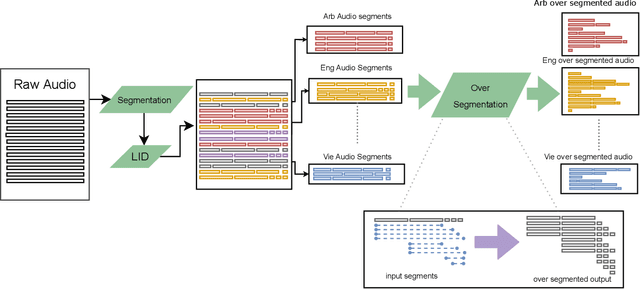
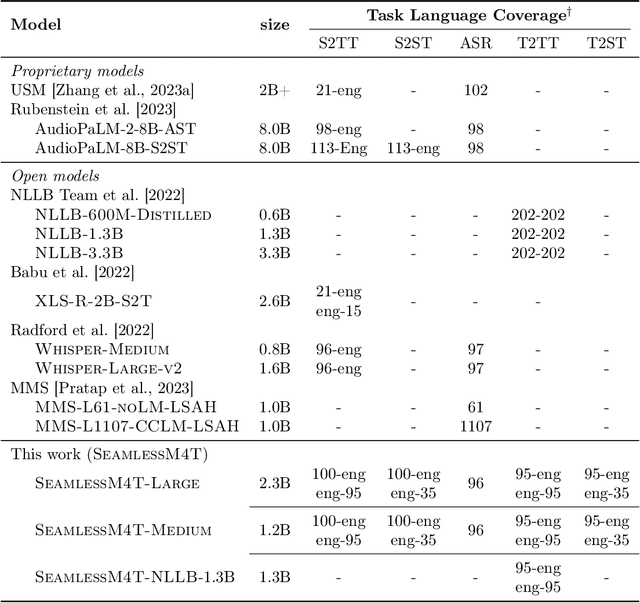
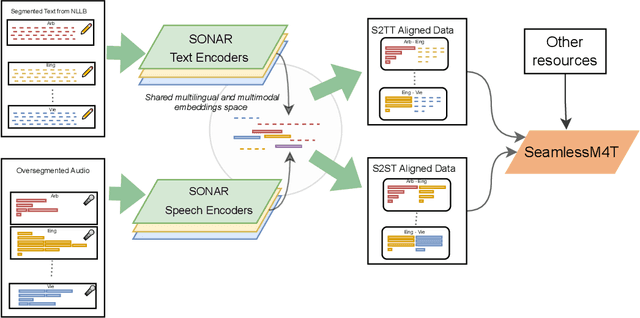
Abstract:What does it take to create the Babel Fish, a tool that can help individuals translate speech between any two languages? While recent breakthroughs in text-based models have pushed machine translation coverage beyond 200 languages, unified speech-to-speech translation models have yet to achieve similar strides. More specifically, conventional speech-to-speech translation systems rely on cascaded systems that perform translation progressively, putting high-performing unified systems out of reach. To address these gaps, we introduce SeamlessM4T, a single model that supports speech-to-speech translation, speech-to-text translation, text-to-speech translation, text-to-text translation, and automatic speech recognition for up to 100 languages. To build this, we used 1 million hours of open speech audio data to learn self-supervised speech representations with w2v-BERT 2.0. Subsequently, we created a multimodal corpus of automatically aligned speech translations. Filtered and combined with human-labeled and pseudo-labeled data, we developed the first multilingual system capable of translating from and into English for both speech and text. On FLEURS, SeamlessM4T sets a new standard for translations into multiple target languages, achieving an improvement of 20% BLEU over the previous SOTA in direct speech-to-text translation. Compared to strong cascaded models, SeamlessM4T improves the quality of into-English translation by 1.3 BLEU points in speech-to-text and by 2.6 ASR-BLEU points in speech-to-speech. Tested for robustness, our system performs better against background noises and speaker variations in speech-to-text tasks compared to the current SOTA model. Critically, we evaluated SeamlessM4T on gender bias and added toxicity to assess translation safety. Finally, all contributions in this work are open-sourced and accessible at https://github.com/facebookresearch/seamless_communication
Multilingual Speech-to-Speech Translation into Multiple Target Languages
Jul 17, 2023Abstract:Speech-to-speech translation (S2ST) enables spoken communication between people talking in different languages. Despite a few studies on multilingual S2ST, their focus is the multilinguality on the source side, i.e., the translation from multiple source languages to one target language. We present the first work on multilingual S2ST supporting multiple target languages. Leveraging recent advance in direct S2ST with speech-to-unit and vocoder, we equip these key components with multilingual capability. Speech-to-masked-unit (S2MU) is the multilingual extension of S2U, which applies masking to units which don't belong to the given target language to reduce the language interference. We also propose multilingual vocoder which is trained with language embedding and the auxiliary loss of language identification. On benchmark translation testsets, our proposed multilingual model shows superior performance than bilingual models in the translation from English into $16$ target languages.
 Add to Chrome
Add to Chrome Add to Firefox
Add to Firefox Add to Edge
Add to Edge